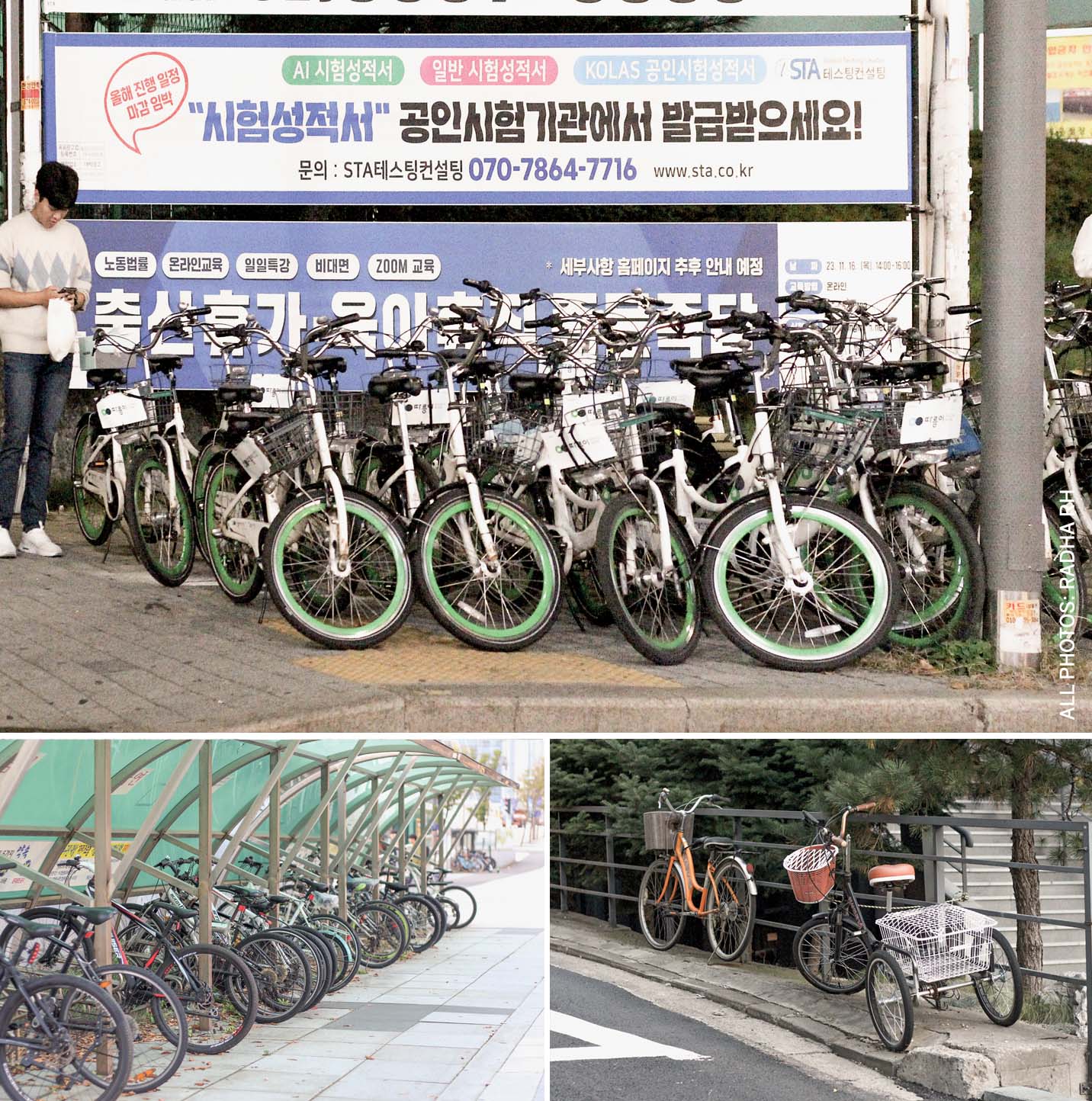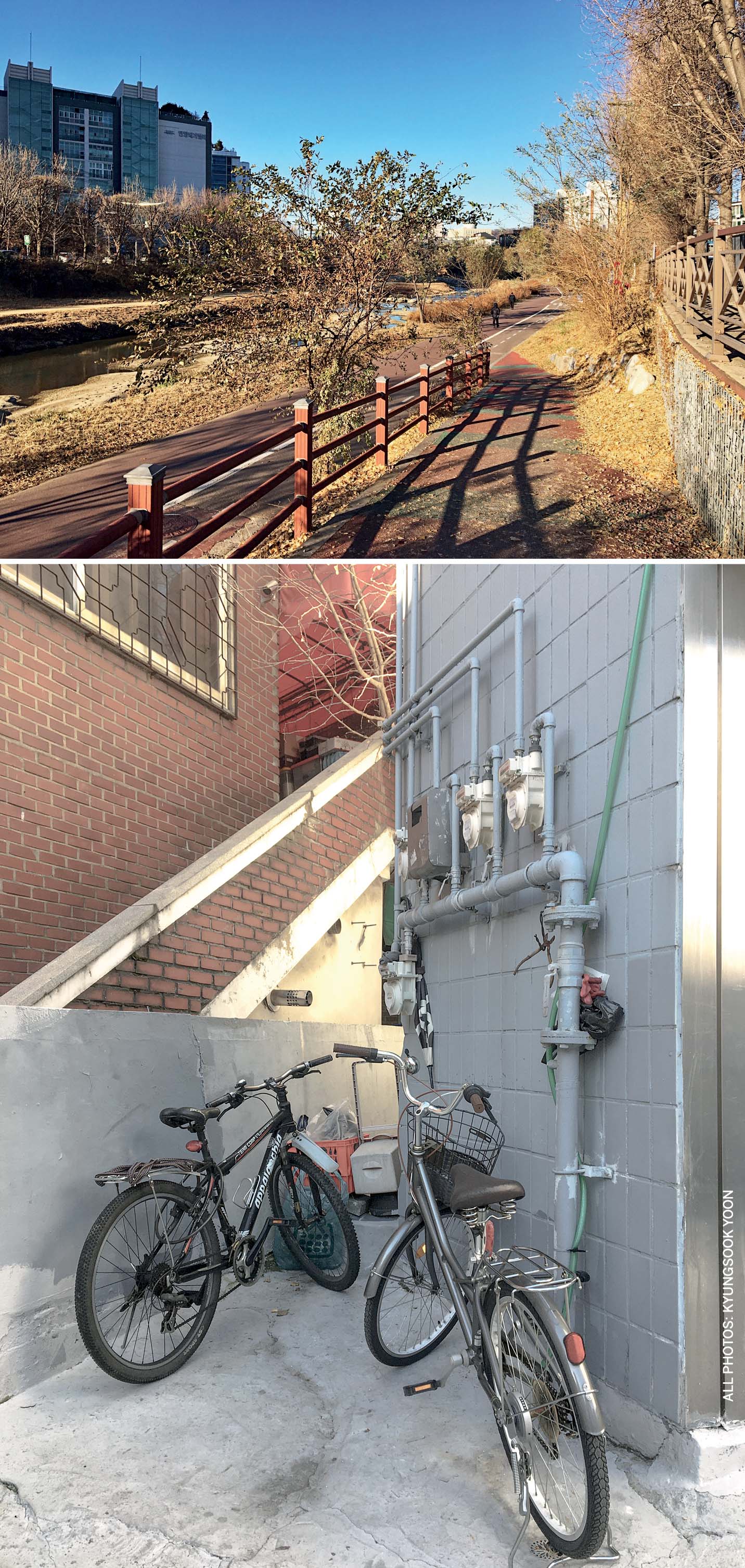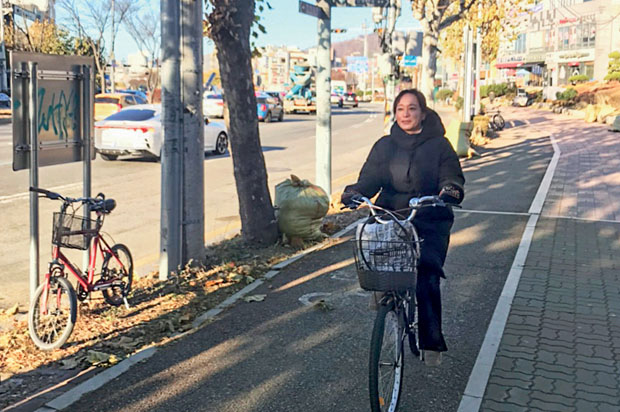Radha: What made you opt for a bicycle over a car for your daily transportation needs? I understand that in South Korean society, the car is seen as a symbol of one’s affluence, and I wonder if this made it all the more challenging for you to make the change when you decided to, back in 2018.
Kyungsook: Yes, the car is a symbol of affluence in South Korean society. At alumni gatherings and other such social events, people are known to ascertain an individual’s success based on their choice of car. We use the term ‘Car Poor’ to describe people who own cars and are in huge amounts of debt, either because of it or despite it. Personally, I think that just the fact that there is a term to describe people who accrue these huge debts in order to buy cars, reflects how common it is for one to do so, as well as the societal pressures that motivate this kind of behaviour.
Even though it has been five years since I made the shift from driving to bicycling and using public transport, my friends and family continue to be surprised that I have been able to do so consistently. One factor that has played a major role in enabling me to do this, is that my place of work is only a ten-minute walk from my home in Anyang. At first, I would often take taxis for longer distances of travel, but as I got more accustomed to using a bicycle, I began to discover its many merits, including its easy manoeuvrability. Now I cycle everywhere and, occasionally, even manage to take my bicycle into the city of Seoul by transporting it on the subway.
The car is viewed as a symbol of affluence in South Korean society

Bottom Left: Bicycling infrastructure at subway stations in Seoul.
Bottom Right : Parked bicycles in Seoul
I have noticed the presence of bicycle infrastructure at most subway stations around South Korea. From what I understand, the prominence and widespread use of bicycles in South Korea is attributed to infrastructure developed by the former President Lee Myung-bak, whose ‘4 Rivers Project’ revolutionised what bicycling was in Korea then and has made it much more accessible and rewarding today. Can you tell me more about this project?
The Korean government had tried to promote bicycling since 1995 but with little success until the Lee Myung-bak government established comprehensive measures for the same, as part of the ‘4 Rivers Project’ in 2009. Though this project ensured that every town and city across South Korea has bicycling lanes along major rivers and their tributaries, I find this policy to be lacking as it only provides incentives for leisurely bicycling as compared to more functional transportation needs.
Save along water bodies, our cities still don’t have adequate bicycling infrastructure, to make bicycling a convenient and attractive mode of daily transportation for people to use. While in other parts of the world, the Covid-19 pandemic caused a significant shift towards bicycling for daily use, in Korea we have not as yet been able to achieve a widespread understanding of environmental issues, and have thus not been able to demand better lifestyles and public infrastructure from our government.
In Korea we have not as yet been able to achieve a widespread understanding of environmental issues
In the 1970s and 1980s, many local streams in Korea and around the world were being polluted by factories along the rivers, in response to which, a global movement began in the late 1980s, to clean up river waters and river fronts. Korea has been at the forefront of this movement and has made significant progress via the ‘4 Rivers Project’. This massive undertaking was completed in 2011, and a rewards programme has since been introduced where people can accrue stamps on a special government issued ‘Bike Passport’ by cycling through and visiting stamp centres along the various bicycle routes across the country.
One of the major tracks that many cyclists attempt, is the one from Seoul to Busan, a city on the southernmost tip of the Korean peninsula, following first the River Han and then the River Nakdong. While this route runs in a north-south direction across Korea, there is also another route that runs east-west, ending in a beautiful stretch along the eastern coast with views of the Sea of Japan. Another scenic route that I would recommend, is the one along the perimeter of Jeju Island, a place that is itself known for its natural beauty. If and when a person completes a full route and collects all the stamps at booths along the way, they are even eligible to receive a certificate from the Korean Water Authority, in recognition of their accomplishment!

Bottom Left and Bottom Right: Parked bicycles in Seoul

Bottom: Kyungsook’s bicycle parking area at work
I had the opportunity to bicycle along the River Han on the stretch that cuts through the city of Seoul, dividing it into north and south. As someone who has found it most challenging to bicycle in India, owing to the humid weather, lack of bicycle infrastructure, potholes and open drains, I found the experience of bicycling in a dedicated bicycle lane along the River Han thoroughly refreshing and enjoyable. I rented a bicycle from Seoul’s bike sharing system called ‘Seoul Bike’ or ‘Ttareungi’ as it is known in Korea. Does Anyang have a similar bike sharing system?
Yes. Bike sharing systems are quite popular across South Korean cities. The one we have in Anyang is called ‘Every Bike’ and is part of a network of bicycles and bicycle docking stations across the Kyunggi Province. Though I have never used it myself, it’s heartening that there are many people benefiting from such a system. The one problem that I have noticed with this system however, is that people often fail to return their rented bicycles to designated docking stations, leaving them astray on roads across the city. I think that this behaviour poses a hazard to others and creates unnecessary clutter in our public spaces.
People often fail to return their rented bicycles to designated docking stations
What you are alluding to is the tragedy of commons, a well-tested theory that people are more wasteful in the handling and usage of public property than they are of their personal belongings. The reason this is particularly interesting to me is because you bring it up in the context of bicycle parking, a subject that after all is my area of expertise. Inspired by Jonas Larson’s paper, ‘Bicycle Parking and Locking: Ethnography of Designs and Practices’, I have spent much time over the last few years documenting parked bicycles in both organised parking stations as well as on the fly. So, I’m curious to know about how and where you park your bicycle daily.
At work, I park my bicycle in a parking lot in front of my office building. This parking lot unfortunately does not have a dedicated bicycle parking stand; however, other tenants use this space to park their bikes and I have followed suit. At home, I live in a multi-family house or apartment building that has a common lobby on the first floor, where I park my bicycle along with several others in the building. Some of my neighbours even use this space to park their strollers and since it is a private area, we don’t feel the need to lock our possessions when we leave them there. When I go into Seoul, I generally park my bicycle in the designated bicycle parking stand present outside subway stations in the city. On occasion, I have forgotten to lock my bicycle but thankfully no one has stolen it as yet. South Korea is generally known to be a rather safe country so I am not usually worried about my bike even if I do leave it unlocked and unattended.
The feeling of safety in South Korea is something that I have enjoyed in my time here. I have been able to travel through the city of Seoul at every hour of the night, using buses and the subway without once having felt the need to escape from an uncomfortable situation. I hope this article will get more people to visit this beautiful country and to bicycle along its many rivers.
I hope so too and I also hope that more people have a chance to fall in love with bicycling as I have over the past few years. Though I have no intention of forcing anyone to change how they commute, I do think that conversations like these open up possibilities for change to happen. Bicycling has not only made me feel healthier and more environmentally responsible, but has also allowed me opportunities to explore my city and to make transport as much about the journey as it is about reaching a destination.



Comments (0)